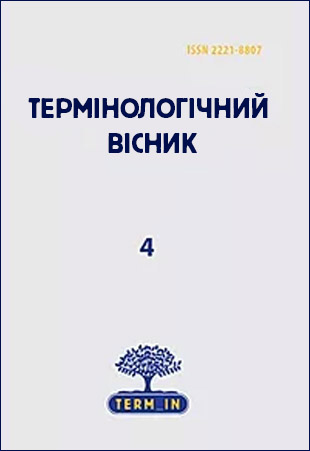General Tendencies in Creating Terms with Greek and Latin Elements in the Forestry Field

Founders
National Academy of Sciences of Ukraine,
Institute of Ukrainian Language of NAS
Publisher
Institute of the Ukrainian Language of National Academy of Sciences of Ukraine
Scientific journal Ukrainian Language is registered by the Ministry of Justice of Ukraine as print media (Certificate: Series КВ № 12180 – 1064 ПР of January 12, 2007).
Included in the list of printed scientific specialized editions of Ukraine (Order of MES of Ukraine no528 from 12.05.2015)
Back side of the journal
Liudmyla Marchuk
Information about the author:
Doctor of Philology, Professor, Ivan Ogijenko National University of Kamianetz-Podilsk (Kamianetz-Podilsk, Ukraine)
e-mail: lyudmyla_marchuk@mail.ru.
Title: General Tendencies in Creating Terms with Greek and Latin Elements in the Forestry Field
Rubric: Branch Terminology
Abstract: According to the genetic classification of borrowings, one of the largest groups of foreign language vocabulary in European languages is formed by lexemes of Latin origin. They are the result of interaction between languages, which are often characterized by a significant degree of genetic and temporal distances. In the article the terminology of Forest industry with the most common terminological elements of Latin and Greek origin is analyzed.
Element – is not a word, but a part of the word (prefix, suffix, root), which is being in grammatical relationship with the other elements, forms independent words-terms. Thus, the element “micro” has no complete meaning of the words but it has the specific semantic loading, which is transferred by the concept “small, not big one”. In words-terms, it indicates the correlation of those words and constant objects, phenomena. And the precise scientific definition is received by term in the process of studying the specific scientific discipline.
Knowledge of the structure of term’s elements explains the meaning of foreign language term, it helps in better understanding.
It is well-known that the terms reflects either one dominant or secondary, or occasional feature, underlying the phenomenon, which reflects, such as color, shape etc. Terminology concept with elements of Greek and Latin origin in the Forest field, can be grouped into major thematic sections.
The initial point for placing elements is a substantive concept, followed by an element that expresses this concept, the indicator of the origin of element, its importance in translation. Elements are usually placed according to antonymous meaning (micro – macro). Due to the polysemy some elements get into different sections.
The group of terms, in which ancient Greek and Latin term elements are distinguishes is very numerous. Terms, formed with the help of classical elements, reflect the process of adaptation (in bigger or less degree) by modern languages.
Thus, the group of terms with the initial parts, the etymons of which are Greek and Latin languages, get into synonymous relations, varying, intersecting or overlapping each other .
The doublet terms – are the words or phrases that are combined by special terminological correlation with the same scientific concepts and object of reality. Thus, a large part of Greek and Latin elements in the terms and terminological combinations function as units of scientific style (root words, derivation and other elements) have the ability to influence the linguistic and cultural nature of language, and, thanks to aesthetically complete words, they intellectualize both speech and a speaker, the a specialist of the field.
Keywords: lexical latinisms, Latin borrowing, Greek-Latin element, Polonism with Latin base.
References:
- Akulenko, V.V. (1962). Holovni istorychni dzherela leksychnykh internatsionalizmiv v ukrainskii movi. In O.O. Potebnia i deiaki pytannia suchasnoi slavistyky (pp. 128–144). Kharkiv: Vyd-vo Khark. un-tu (in Ukr.).
- Biletskyi, A.O. (1966).Slovianska toponimiia Hretsii. Povidomlennia Ukrainskoi onomastychnoi komisii, Vyp. 1, 13–24 (in Ukr.).
- Vinokur, G.O. (1939). Problema kul’tury rechi. Russkij yazyk v sovetskoj shkole, 1939, № 5, 85 (in Rus.).
- Golovin, B.N. (1987). Lingvisticheskie osnovy ucheniya o terminah. Moscow: Vysshaya shkola (in Rus.).
- Danilenko, V.P. (1977). Russkaya terminologiya: opyt lingvisticheskogo opisaniya. Moscow (in Rus.).
- Hrytsenko, S.P. (1999). Leksychnyi vplyv yak chynnyk dynamiky struktury movy-retsypiienta (na materiali latynskykh zapozychen ukrainskykh pamiatok k. XVI – XVII st. [Synopsis of PhD thesis]. Kyiv (in Ukr.).
- Yarcev, V.N. (Ed.) (1990). Lingvisticheskij enciklopedicheskij slovar’. Moscow: Sov. Enciklopediya (in Rus.).
- Derkach, P.M. (Ed.) (1993). Korotkyi slovnyk synonimiv ukrainskoi movy. Lviv: Prosvita (in Ukr.).
- Kunch, Z.Y. (1996). Leksyko-henetychni osoblyvosti suchasnoi ukrainskoi rytorychnoi terminolohii. Movoznavstvo, 1996, № 4–5, 49–56 (in Ukr.).
- Lotte,D.S. (1961). Osnovy postroeniya nauchno-tekhnicheskoj terminologii. Moscow: Izd-vo AN SSSR (in Rus.).
- Lotte, D.S. (1971). Kratkie formy nauchno-tekhnicheskoj terminologii. Moscow: Nauka (in Rus.).
- Lukinova, T.B. (2013). Ukrainska leksyka: semantychni zminy v zapozychenykh slovakh. Movoznavstvo, 2013, № 2–3, 18–38 (in Ukr.).
- Molodets, V.M. (1978). Klasyfikatsiia synonimiv rosiiskykh i nimetskykh linhvistych¬nykh terminiv za movoiu-dzherelom. Movoznavstvo, 1978, № 3, 51–55 (in Ukr.).
- Mrozitska, U.L. (2002). Intra- ta ekstralinhvalni chynnyky rozvytku movy-retsypiienta (na materiali latynskykh zapozychen v ukrainskii movi) [Synopsis of PhD thesis]. Kyiv (in Ukr.).
- Nahina, V.O. (1989). Osnovni tendentsii rozvytku ukrainskoi meteorolohichnoi terminolohii. Movoznavstvo, 1989, № 5, 61–67 (in Ukr.).
- Nikitina, F.O. (1996). Zasoby strukturyzatsii internatsionalnykh terminiv v ukrainskii naukovii terminolohii. Movoznavstvo, № 4–5, 57–69 (in Ukr.).
- Ponomariv, O. (2005). Leksyka hretskoho pokhodzhennia v ukrainskii movi. Kyiv: Prosvita (in Ukr.).
- Semchynskyi, S.V. Latynizm. In Ukrainska mova: Entsyklopediia (pp. 292). Kyiv: Vyd-vo “Ukr. entsykl.” im. M. P. Bazhana (in Ukr.).
- Pustovit, L.O. (Ed.) (2000). Slovnyk inshomovnykh sliv. Kyiv: Dovira UNVTs Ridna mova (in Ukr.).
- Stashko, M. (1998). Absoliutni synonimy v bibliotechnii terminolohii. In Ukrainska terminolohiia i suchasnist [zb. nauk. prats] (pp. 178–180). Kyiv (in Ukr.).
- Styshov, O.A. (1999). Osoblyvosti rozvytku leksychnoho skladu ukrainskoi movy kintsia XX st. Movoznavstvo, №1, 7–21 (in Ukr.).
- Ukrainska entsyklopediia lisivnytstva (Vol. 1–2) (1999). Lviv: Zhovkivska drukarnia vyd-va Ottsiv Vasylianiv “MISIONER” (in Ukr.).


